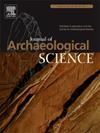The glaze is less opaque on the other side: The development of Egyptian and southern Levantine glazed ceramic production from the early Islamic to Crusader periods
IF 2.5
1区 地球科学
Q1 ANTHROPOLOGY
引用次数: 0
Abstract
Our study seeks to explore the beginnings and spread of glazed ceramic technologies across Islamic lands by focusing on the evidence from the southern Levantine coast. We selected 98 glazed ceramic samples recovered through stratified excavations of four sites along the southern Levantine coast. These ceramic samples include glazed tableware (especially the ones that do not feature the use of opaque glaze) and cooking vessels that are representative of the range of ware types dating to the early Islamic and Crusader periods (9th to 13th centuries CE) in the region. All samples were subjected to technological reconstruction based on the data we generated using petrographic analyses and scanning electron microscopy energy dispersive spectrometry. A subset of 30 glazed ceramics were submitted for portable laser ablation (pLA) sampling for lead isotope analysis – making our study one of the first to test this sampling method on lead-based glazed materials.
Our results show that the production and consumption habits of glazed ceramics was embedded in, and thus susceptible to, the broader historical developments. The vast majority of glazed ceramics dating to the early Islamic period (9th to 11th centuries CE) were imported from Egypt, which were made using pre-existing technologies. Our findings also highlight the importance of cross-craft and -cultural interactions, which serve to mark a departure from the traditional narrative on the beginnings and spread of glazed ceramic production across Islamic lands. We further noticed a greater presence of glazed ceramics that were produced along the Levantine coast, possibly in Beirut and/or northern Israel, from the end of the Islamic Fatimid caliphate to the Crusader periods (11th to 13th centuries CE), using technologies different from the Egyptian workshops. The results of our lead isotope analysis reveal that while the ores from Iran remain to be the main lead sources from the early Islamic to Crusader periods, the Egyptian and Levantine workshops also had access to different ore sources, namely in Tunisia and Sardinia, respectively, largely reliant on the exchange networks they were part of.
另一边的釉面不太透明:从早期伊斯兰到十字军时期,埃及和黎凡特南部釉面陶瓷生产的发展
我们的研究旨在通过关注黎凡特南部海岸的证据,探索釉面陶瓷技术在伊斯兰土地上的起源和传播。我们选择了98个釉面陶瓷样品,这些样品是通过对黎凡特南部海岸四个遗址的分层挖掘而获得的。这些陶瓷样品包括釉面餐具(特别是那些没有使用不透明釉的餐具)和烹饪器皿,这些器皿可以追溯到该地区早期伊斯兰和十字军时期(公元9世纪至13世纪)。所有样品都根据岩石学分析和扫描电子显微镜能量色散光谱法产生的数据进行了技术重建。30种釉面陶瓷被提交用于便携式激光烧蚀(pLA)取样进行铅同位素分析,这使我们的研究成为第一个在铅基釉面材料上测试这种取样方法的研究之一。我们的研究结果表明,釉面陶瓷的生产和消费习惯嵌入在更广泛的历史发展中,因此容易受到影响。大部分早期伊斯兰时期(公元9世纪至11世纪)的釉面陶瓷都是从埃及进口的,使用的是已有的技术。我们的研究结果还强调了跨工艺和文化互动的重要性,这标志着对釉面陶瓷生产在伊斯兰土地上的起源和传播的传统叙述的背离。我们进一步注意到,在黎凡特海岸,可能在贝鲁特和/或以色列北部,从伊斯兰法蒂玛哈里发王朝末期到十字军时期(公元11至13世纪),使用不同于埃及作坊的技术,生产了更多的釉面陶瓷。我们的铅同位素分析结果显示,虽然从早期伊斯兰到十字军时期,来自伊朗的矿石仍然是主要的铅来源,但埃及和黎凡特的作坊也可以获得不同的矿石来源,即分别在突尼斯和撒丁岛,这在很大程度上依赖于它们所处的交换网络。
本文章由计算机程序翻译,如有差异,请以英文原文为准。
求助全文
约1分钟内获得全文
求助全文
来源期刊

Journal of Archaeological Science
地学-地球科学综合
CiteScore
6.10
自引率
7.10%
发文量
112
审稿时长
49 days
期刊介绍:
The Journal of Archaeological Science is aimed at archaeologists and scientists with particular interests in advancing the development and application of scientific techniques and methodologies to all areas of archaeology. This established monthly journal publishes focus articles, original research papers and major review articles, of wide archaeological significance. The journal provides an international forum for archaeologists and scientists from widely different scientific backgrounds who share a common interest in developing and applying scientific methods to inform major debates through improving the quality and reliability of scientific information derived from archaeological research.
 求助内容:
求助内容: 应助结果提醒方式:
应助结果提醒方式:


